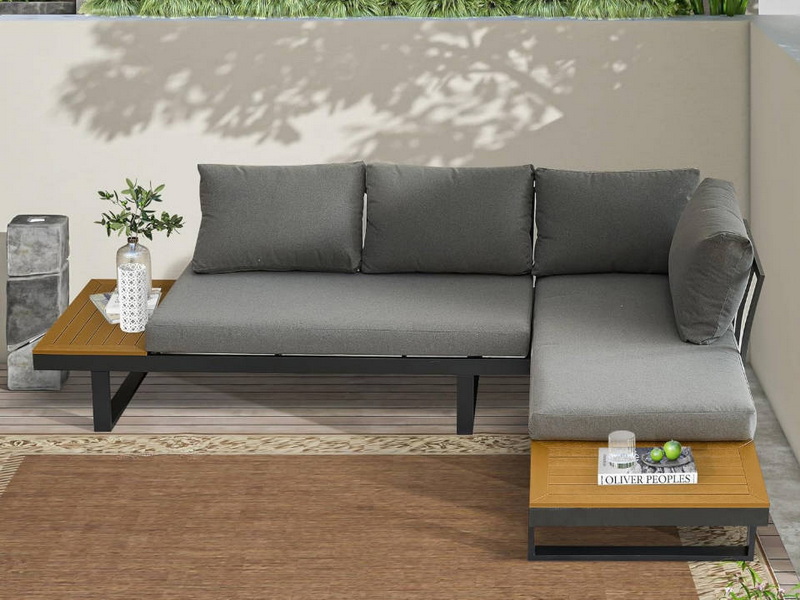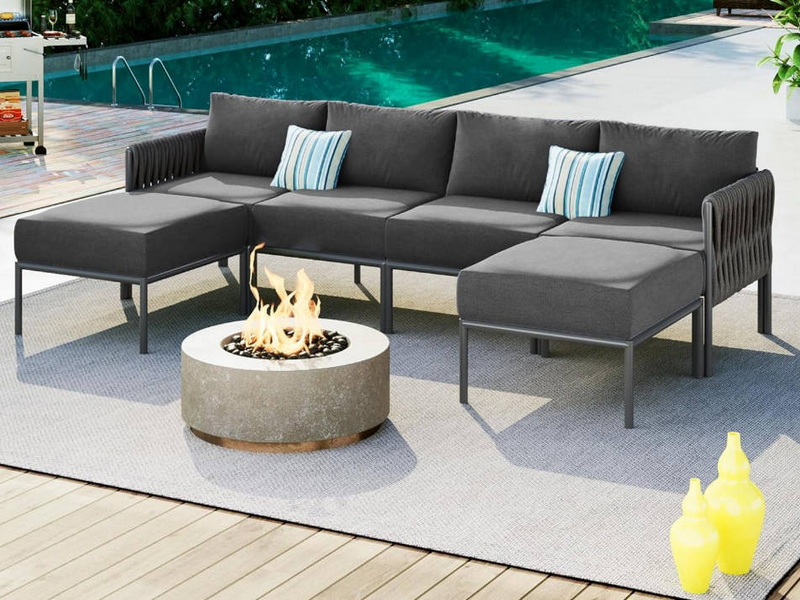English 




Views: 222 Author: Astin Publish Time: 2025-03-05 Origin: Site



Content Menu
● Introduction to Steel and Aluminum
>> 1. What are the primary advantages of aluminum over steel for outdoor furniture?
>> 2. Is steel outdoor furniture more durable than aluminum?
>> 3. How does the cost of steel compare to aluminum for outdoor furniture?
>> 4. Which material is more environmentally friendly, steel or aluminum?
>> 5. Can aluminum outdoor furniture withstand high winds?
When it comes to choosing the best material for outdoor furniture, homeowners often find themselves torn between two popular options: steel and aluminum. Both materials have their unique advantages and disadvantages, making the decision a bit challenging. In this article, we will delve into the characteristics of steel and aluminum, exploring their durability, maintenance requirements, aesthetic appeal, and environmental impact to help you make an informed choice.

Steel and aluminum are both metals widely used in outdoor furniture due to their durability and versatility. However, they differ significantly in terms of weight, corrosion resistance, and cost.
Steel is renowned for its strength and durability, making it an excellent choice for outdoor furniture that needs to withstand harsh weather conditions and heavy use. It is particularly beneficial in areas with high winds, as its weight provides stability against gusts. However, steel furniture can be heavy, making it difficult to move around, and it requires regular maintenance to prevent rust, especially in humid or coastal environments. The weight of steel also means that it can be more challenging to transport and install, which may add to the overall cost.
Steel furniture can be finished in various ways, such as powder coating or galvanizing, which enhance its durability and aesthetic appeal. These finishes not only protect the steel from corrosion but also provide a wide range of colors and textures, allowing homeowners to match their furniture with their outdoor decor. Additionally, steel can be combined with other materials like wood or wicker to create a unique and stylish look.
Aluminum, on the other hand, is lightweight and corrosion-resistant, making it a low-maintenance option. It is easier to move and rearrange, which is ideal for homeowners who like to change their outdoor layout frequently. Aluminum furniture also offers a sleek, modern aesthetic and can be molded into various shapes, providing a wide range of design options. Its lightweight nature makes it easier to transport and install, reducing the overall cost compared to steel.
Aluminum is naturally resistant to corrosion, which means it does not require additional protective coatings like steel does. This makes it a great choice for areas with high humidity or near the ocean, where rust can be a significant issue. However, aluminum can be more prone to scratches and dents due to its softer nature compared to steel.
Both steel and aluminum are durable materials, but they differ in how they withstand environmental factors.
- Steel: Steel furniture is heavier and generally more resistant to wear and tear. However, it can rust if not properly coated or maintained, which can reduce its lifespan. Regular maintenance is crucial to ensure that steel furniture remains in good condition over time. This includes applying protective coatings, cleaning regularly, and storing it during harsh weather conditions if possible.
- Aluminum: Aluminum is naturally resistant to corrosion and does not rust, making it a maintenance-free option. Its lightweight nature means it can be more susceptible to damage from high winds, but it is generally durable and long-lasting. Aluminum furniture can withstand various weather conditions without needing additional protective measures, making it ideal for busy homeowners who don't want to spend a lot of time maintaining their outdoor furniture.

Maintenance is a crucial factor when choosing outdoor furniture.
- Steel: Requires regular maintenance to prevent rust, especially in humid or coastal areas. This can involve applying protective coatings, cleaning regularly, and storing it during harsh weather conditions if possible. While steel can be durable, neglecting its maintenance can lead to premature wear and tear.
- Aluminum: Naturally resistant to corrosion, making it a low-maintenance option. It can withstand various weather conditions without needing additional protective measures. However, it's still important to clean aluminum furniture regularly to maintain its appearance and prevent dirt buildup.
The aesthetic appeal of outdoor furniture can greatly impact the overall look of your outdoor space.
- Steel: Offers a sturdy, traditional look that can be enhanced with various finishes. However, it may not be as versatile in terms of design options compared to aluminum. Steel furniture can be combined with other materials to create a unique look, but its weight and rigidity limit its design flexibility.
- Aluminum: Provides a sleek, modern aesthetic with clean lines. It can be molded into intricate shapes, offering a wide range of design possibilities. Aluminum furniture is often used in contemporary outdoor settings, where its minimalist style complements the surroundings.
Considering the environmental impact of your outdoor furniture is becoming increasingly important.
- Steel: While steel is recyclable, its production process can have a higher carbon footprint compared to aluminum. Additionally, the mining and processing of iron ore for steel production can have environmental consequences. However, steel is highly durable and can last for many years, reducing the need for frequent replacements.
- Aluminum: Also recyclable and often produced using low-carbon hydro-electricity, making it a more sustainable option. Aluminum production requires less energy than steel, and its lightweight nature reduces transportation emissions. However, extracting bauxite, the primary ore for aluminum, can have environmental impacts.
The cost of outdoor furniture is another significant factor to consider.
- Steel: Generally more expensive than aluminum, especially when considering high-quality, rust-resistant coatings. The weight and durability of steel also mean that it can be more costly to transport and install. However, its long lifespan can offset these costs over time.
- Aluminum: Offers a balance between cost and quality, providing durable furniture at a reasonable price. Its lightweight nature makes it easier and less expensive to transport and install. Additionally, aluminum furniture often requires less maintenance, which can save money in the long run.
Both steel and aluminum offer opportunities for customization, but they differ in their design flexibility.
- Steel: While steel can be shaped into various forms, its weight and rigidity limit its design flexibility compared to aluminum. However, steel can be combined with other materials like wood or fabric to create unique designs.
- Aluminum: Offers a high degree of design flexibility due to its lightweight and malleable nature. It can be molded into intricate shapes and designs, making it ideal for modern and contemporary outdoor settings.
Seasonal changes can impact the choice of outdoor furniture.
- Steel: In colder climates, steel furniture may become icy and slippery, requiring additional safety measures. However, its weight provides stability in snowy conditions, making it less likely to be blown away.
- Aluminum: In warmer climates, aluminum furniture can become hot to the touch, requiring cushions or covers for comfort. Its lightweight nature means it may need to be secured in windy conditions.
Choosing between steel and aluminum for outdoor furniture depends on your specific needs and preferences. If you prioritize durability and stability in high-wind areas, steel might be the better choice. However, if you prefer a lightweight, low-maintenance option with a modern aesthetic, aluminum is likely the way to go. Both materials offer excellent durability and can enhance your outdoor space, but it's essential to consider factors like maintenance, cost, and environmental impact when making your decision.

Aluminum is lighter, easier to move, and requires less maintenance due to its natural resistance to corrosion. It also offers a modern aesthetic and can be molded into various designs.
Steel is heavier and generally more resistant to wear and tear, but its durability can be compromised if it rusts. Aluminum, while lighter, is naturally resistant to corrosion and can be just as durable with proper care.
Steel is generally more expensive than aluminum, particularly when considering the cost of rust-resistant coatings. Aluminum offers a balance between cost and quality.
Aluminum is often considered more environmentally friendly due to its recyclability and lower carbon footprint in production. However, both materials are recyclable and can be sustainable options.
Aluminum furniture is lightweight and may not withstand high winds as well as steel. However, there are ways to secure it, such as using anchors or heavier bases, to prevent it from blowing away.
[1] https://pbzmfg.com/blog/aluminum-vs-steel-patio-furniture/
[2] https://www.castlery.com/us/blog/8-most-durable-outdoor-furniture-materials
[3] https://blog.csdn.net/weixin_40289064/article/details/79669930
[4] https://www.whitestores.co.uk/blog/post/is-steel-or-aluminium-better-for-outdoor-furniture
[5] https://www.smow.com/styla/topics/colours-materials/materials-for-outdoor-furniture
[6] https://www.163.com/dy/article/EDIGQUV605370K28.html
[7] https://www.hineighbor.com/blogs/the-journal/aluminum-vs-steel-patio-furniture
[8] https://www.hineighbor.com/blogs/the-journal/best-material-for-outdoor-furniture
[9] https://jphe.amegroups.org/article/view/4265/10863
[10] https://www.astrastreetfurniture.com.au/learning-centre/learning-centre/which-is-better-when-it-comes-to-outdoor-furniture-steel-or-aluminium/
[11] https://www.patioproductions.com/blog/patio-furniture/best-material-for-outdoor-furniture/
[12] https://blog.csdn.net/qq_34917728/article/details/125122327
[13] https://www.youtube.com/watch?v=j_icsqNGGs4
Top Aluminum Furnitures Manufacturers and Suppliers in Czech Republic
Top Aluminum Furnitures Manufacturers and Suppliers in Poland
Top Aluminum Furnitures Manufacturers and Suppliers in Belgium
Top Aluminum Furnitures Manufacturers and Suppliers in Finland
Top Aluminum Furnitures Manufacturers and Suppliers in Denmark
Top Aluminum Furnitures Manufacturers and Suppliers in Greece
Top Aluminum Furnitures Manufacturers and Suppliers in Portugal
Top Aluminum Furnitures Manufacturers and Suppliers in Austria
Top Aluminum Furnitures Manufacturers and Suppliers in Norway
Top Aluminum Furnitures Manufacturers and Suppliers in Sweden
